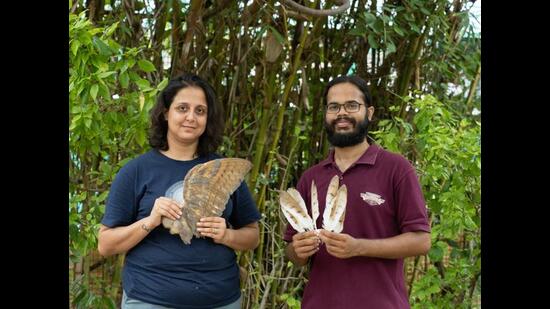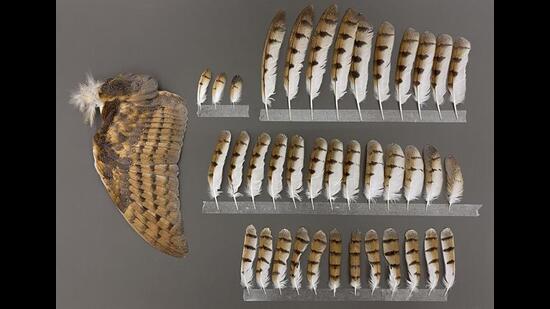A digital feather library has just been fluffed out. It contains high-resolution images of wings and feathers from at least 50 species, with more being added. Alongside each colourful spread, viewers can find details of the bird’s weight, body length, beak width, etc, along with the date, location and cause of death.
A first-of-its-kind repository for Indian birds, the aim is to aid avian research and help in the niche field of feather transplants. The resource is accessible to the public free, and aims to also help birders identify species they’ve spotted.
Featherlibrary.com was launched on November 15, 2021, co-founder Esha Munshi’s 34th birthday. “It was a birthday gift to myself,” she says, laughing. The repository is the brainchild of Munshi, a former architect, an avid birdwatcher and a citizen scientist, and veterinarian Sherwin Everett, 30, who is also a wildlife rehabilitator and hospital curator with the Jivdaya Charitable Trust in Ahmedabad.
As fellow birders in Ahmedabad, Munshi and Everett often flocked together. Munshi is a passionate twitcher. By her estimate, she has spotted 1,060 of India’s 1,300-odd bird species. If there’s news of a rare sighting somewhere in India, she hits the road and tries to add it to her tally.
Confined to her home during the lockdown, she heard a call of a different kind. An Indian silverbill somehow got through her layers of protective netting (installed to keep her cats from attacking birds) and one of her cats got to it. She rescued and released it unhurt, but it left a feather behind.
It was just so tiny, Munshi says. “There I was, holding a little feather, smaller than my little finger, which was one of the longest for this bird.” She looked for online repositories where she could learn more about the feather, or compare it to others. When she couldn’t find one for Indian birds, she decided to build one herself.

Later, she would learn that there were very few such resources in the world: Featherbase is an independent database run out of Germany, and Feather Atlas is managed by the US Fish and Wildlife Service.
Everett was the perfect partner for Munshi’s initiative. As a captive management expert, he has been working with injured birds for 10 years. One of the practices he and former clinical director Dr Shashikant Jadhav have been working on at Jivdaya is feather implants. “It’s an old falconry practice where they use the feathers of a dead bird to replace the damaged feather of a live bird,” Everett says.
This requires very specific knowledge of feathers and how they are arranged on the wings and body. “A wrong feather in the wrong place will alter the bird’s flight, and the bird could end up having problems hunting, foraging, flying to escape etc,” says Everett. “So when Esha came to me with this great idea of digitising data, I signed on.”
Featherlibrary.com will act as a reference point for feather transplants. Based on availability, actual feathers can also be drawn from the library.
A collaboration with Jivdaya gives the duo access to deceased birds from across the region. But digitising is the last step in the process, which begins with preparing the specimens. With some training from Everett, who has dabbled in taxidermy, Munshi has begun to clip wings and ready samples for the database.
This bit hasn’t been easy. One of the more brilliantly coloured specimens in the collection, for instance, is an Indian pitta. The idea of working on this species paralysed Munshi for 10 minutes, she says. “I had always seen them from so far away and recorded their beautiful sounds. As a birdwatcher, I choked.”

She did it anyway, starting with freezing the body for 24 hours, to kill any pathogens in the blood and any lice on the body. Next, the wings were cut off, injected with ethanol and left to dry at room temperature. At this stage, initially, the skin would shrink as the ethanol and moisture from the muscles evaporated, and the wing often ended up bent. Munshi learnt how to work around this during a two-week visit to the Cornell Lab of Ornithology in New York State.
“One of the techniques we learnt from Cornell was to pin the wing down during the drying process, to create a perfectly straight and flat specimen,” Munshi says. A small bird wing, say from a kingfisher, takes about a day to dry, whereas a bigger bird with more muscle, like a flamingo, takes a few days of periodically injecting spirit before it’s ready.
Munshi and Everett are now expanding the scope of their project. Upcoming features include X-rays (for skeletal structure) and CT scans (for muscular and organ data) of the entire specimen before it is dissected; gut data, for information on what the birds eat; and sex determination.
Munshi and Everett have also started the Feather Library Charitable Trust, through which they are applying for funding so they can set up a lab. “Eventually we’d like to have a museum where people can come and view the specimens too,” Munshi says.
Enjoy unlimited digital access with HT Premium
Subscribe Now to continue reading

Stay connected with us on social media platform for instant update click here to join our Twitter, & Facebook
We are now on Telegram. Click here to join our channel (@TechiUpdate) and stay updated with the latest Technology headlines.
For all the latest Art-Culture News Click Here
